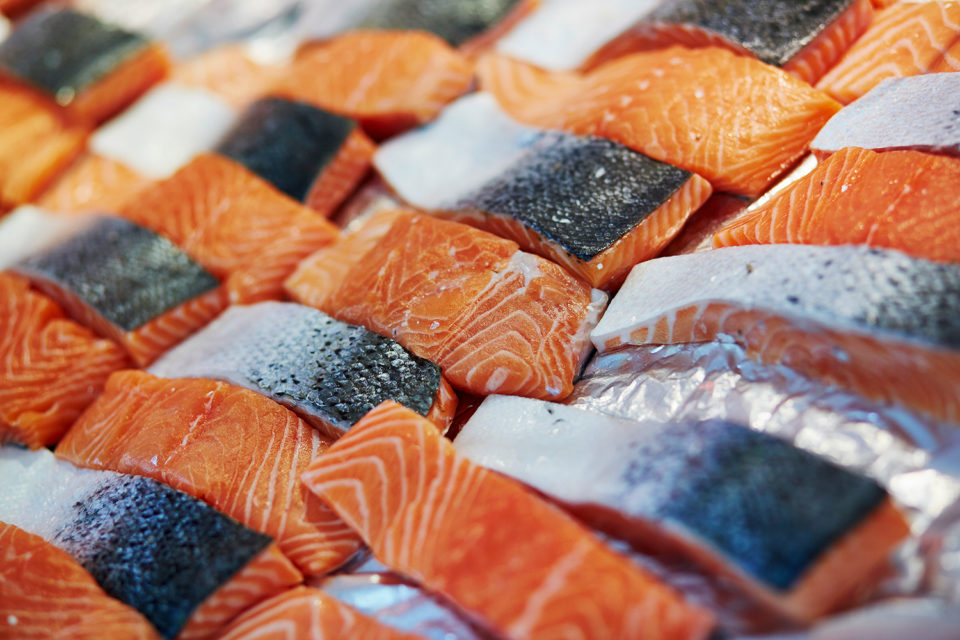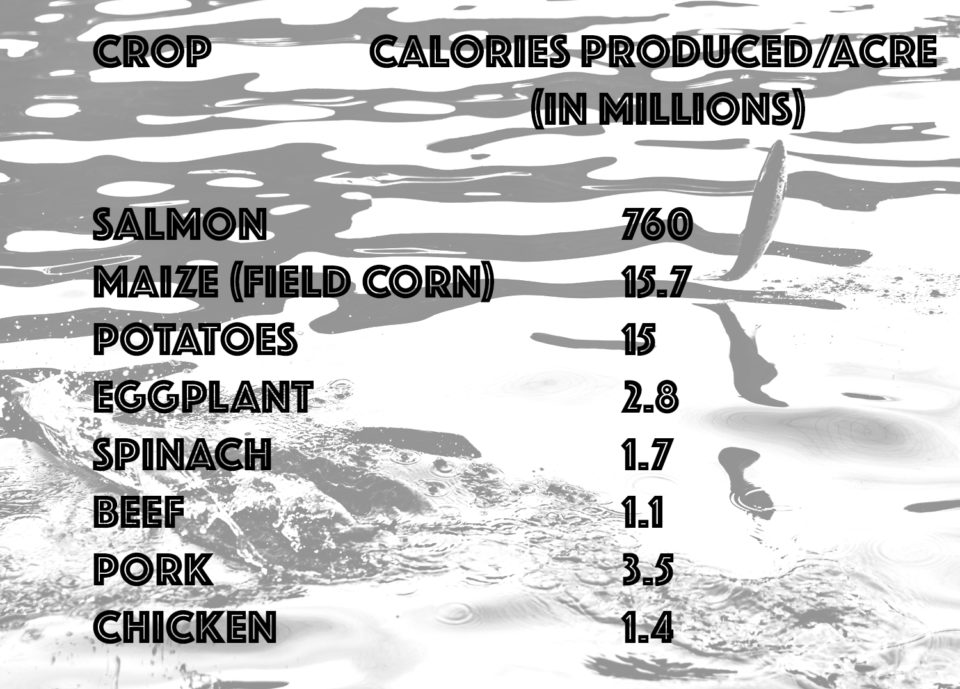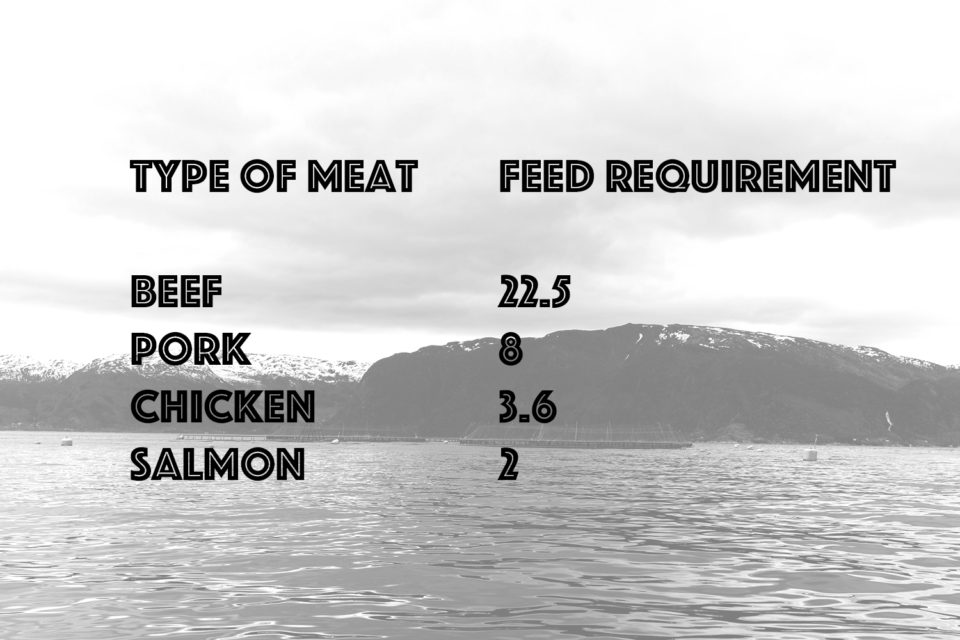Compared to terrestrial agriculture, aquaculture is a far more efficient way to produce the food that fuels us

Agriculture is the most crucial of human endeavors. Whittled down to its irreducible essence, agriculture has two missions – to provide us with the calories and the nutrition we require to live.
Throughout its 11,000-year history, agriculture has adapted, sometimes slowly (putting animals in pens) and sometimes rapidly (the green revolution) to shifting demands. But it’s never seen anything like what’s coming.
In the next 20 years the world’s population will increase by 2 billion people. Our aggregated wealth is growing rapidly and with that comes a change in what people desire on their dinner tables. To feed us all, we need to double food production over the next 25 years.
Such agricultural change is unprecedented. How will food producers simultaneously meet their looming quantitative and qualitative callings? Counting calories has never been so important; our future hangs on counting enough of them.
I suggest we make our calories truly count.
From here to the 2040s
Agriculture currently uses 38 percent of the world’s land. Of the remaining land, climactic or soil quality constraints render 33 percent unsuitable for any kind of agriculture. Another 14 percent is in parks and reserves. So, we can’t even nip at the heels of doubling agricultural acreage.In one respect, this knowledge should give us great clarity about the future of our food supply. When we think about our path forward, what we know for certain is that it’s not the path we’re currently on.
Our sobering challenge is to create the food systems that provide the calories andthe nutrition we’ll need in 25 years. To do that, we face a simple fact: It’s unusual for calories and nutrition to come bundled together in the same item. Starch-based calories – beans, grains, maize, rice and potatoes – arrive on our plates easily and plentifully. In contrast, more nutritionally dense foods, whether plants or animals, consume more land inputs, making them relatively harder to come by.
Can fish be the future?
One thing we should consider is a turn to the oceans that cover about 70 percent of the world’s surface. However, the fish that the oceans supply constitute only 16 percent of the protein that humans consume.
While fish are a quantitatively small part of our diets, qualitatively they are nutritional giants. Public health scientists and dietitians alike argue that we should eat more seafood, particularly oily fish, than we currently do for their superb nutritional content. But as we consider fish, can we have more than we do now?
As a food source, fish are unique. Half of what we consume comes from hunting wild fish and half comes from aquaculture, or fish farms. Every other thing we buy at the grocery store is invariably farmed. This dynamic exists in no other food sector.
To understand the status of wild fisheries and fish farms, the FAO undertakes a biennial oceans assessment called State of World Fisheries and Aquaculture. Its 2006 report found 75 percent of wild fisheries harvested at or above their sustainable limits. The 2014 edition found that fully or overly harvested fisheries rose to 90 percent which is the same dismal number reported in 2016. This means there is no way for wild fish to satisfy growing needs. Harvests can’t increase. In fact, they should decrease to allow challenged stocks to replenish themselves.
Here again, we have another point of clarity about our food future. As our population expands, wild fish will become a smaller part of our diet. If fish are to be a meaningful part of the future, we need to farm them like everything else we eat. But what does that mean from an environmental perspective?
The productivity and resource requirements of farmed fish
The environmental impediments to expanding wild fish harvest provide a cautionary tale as we think about expanding aquaculture. Aquaculture should be examined for its environmental suitability. At a minimum it should perform better than other areas of agriculture. Ideally it will give us more calories and more nutrition on less space with fewer resources and lower environmental impact.
For now, let’s look at other areas starting with how salmon farming provides calories and nutrition. Examining salmon aquaculture is a good choice as salmon is the second-most consumed seafood in the United States and farms produce about 70 percent of it.
What does a salmon farm provide?
The Faroe Islands arguably have the strictest national regulations for salmon aquaculture amongst the world’s salmon-farming nations. They mandate no more than 25 kg of salmon per cubic meter of water but their actual performance is about 15.4 kg. This is to ensure we address the second of our agricultural imperatives; farms with lower densities have lower environmental impacts.
How much food does that actually provide? For our purposes, let’s envision a farm that performs efficiently and conservatively, with only 14 kg of salmon per cubic meter (or, in other terms, three mature salmon per metric ton of water).
A typical salmon farm occupies about 2.2 acres of ocean surface and it produces about two and a half billion calories worth of salmon per crop (which takes a year and a half to grow). Putting this on the same basis as the numbers in the table above, a salmon farm produces 760 million calories per surface acre per year.

Salmon farms, then, are quite different from terrestrial farms in providing both nutrition and calories. Moreover, they produce stunningly more of both than their land-based counterparts: 270 and 450 times more calories, respectively, than nutrient-rich eggplant and spinach crops; 48 times what’s in calorie-rich starchy crops; and 200 to 700 times more calories per acre than the animals we farm on land.
What does a salmon farm consume?
Farm animals must be fed. Their feed comes from other agricultural resources grown and then transformed to feed ingredients. Metabolic differences between farm animals and differences in the portion of those animals we actually eat contribute to the environmental footprint of animal agriculture.

As we consider resource utilization in our future food supply, quite clearly salmon offers the promise of producing a lot more food with a lot less input. This makes sense.
Fish are the most efficient of farm animals. They’re cold-blooded so use no energy to maintain their body temperature as land animals must. They don’t spend calories fighting gravity to stay upright, nor do they require energy to build a bone structure to support their weight. In terms of yield, we eat a much greater percentage of a small-boned fish than we do from large-boned land animals.
Let’s return to the question of agriculture’s challenge to meet our need for both calories and nutrition. Aquaculture in general and salmon aquaculture in particular are certainly poised to contribute meaningfully to our future food needs. Fish farming makes a much smaller call on resources than other types of animal agriculture, and it provides nutritious food that should be a larger part of our diets. It’s not the sole answer to “What’s for dinner?” in 2040. But it’s a big part of the answer and at the very center of a hopeful food future.
Follow the Advocate on Twitter @GAA_Advocate
Author
-

Scott Nichols
Scott Nichols is the founder of Food’s Future, LLC where he advises businesses to help them create economically and environmentally sustainable aquaculture ventures that provide seafood to an expanding world. He is a speaker on the role of aquaculture in our future food supply, a member of the board of directors at the Aquaculture Stewardship Council and a scientific advisor to Seafood Nutrition Partnership.
Tagged With
Related Posts

Responsibility
On GM foods, part 1: Let’s move this unproductive conversation forward
In the first part of a series on genetically modified foods, independent advisor Scott Nichols discusses the simplistic decision behind product labels and the more complex question of what could and should be the outcomes of its use.

Innovation & Investment
Aquaculture Exchange: Scott Nichols, Food’s Future
Scott Nichols speaks to the Advocate about the launch of his own consultancy, Food’s Future, about groundbreaking innovations at Verlasso and about the role of aquaculture in a rapidly changing world — one in need of collaboration and new ideas.

Aquafeeds
SeaWeb Seafood Summit: Defining the future of aquafeed
At the Barcelona Seafood Summit, an expert panel discussed a sustainable future for aquafeeds. What stands between us and that future?

Aquafeeds
Bridging the omega-3 gap with methane, microalgae
Innovation is leading to new ingredient options for renewable sources of omega-3 fatty acids. But Replicating long chain fatty acids is a tall order, Advocate contributor Lisa Duchene discovered.

